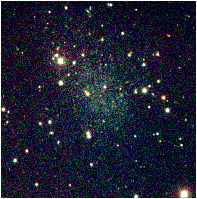A New Local Group Galaxy
A New Local Group Galaxy: The Antlia Dwarf Galaxy
 Astronomers in Cambridge have discovered a new member of the Local Group
of Galaxies in a region of space previously thought to be devoid of nearby
dwarf galaxies. The newly discovered galaxy is in the constellation of
Antlia and is important because it is one of a very select club of isolated
Local Group members. Most Local Group galaxies are satellites of the Milky
Way and Andromeda systems leaving only a few outliers to use as probes of the
dynamical evolution of the Local Group and for characterising the unperturbed
evolution of nearby dwarf galaxies. Astronomers had previously overlooked
the galaxy because of its low surface brightness relative to the night sky.
Astronomers in Cambridge have discovered a new member of the Local Group
of Galaxies in a region of space previously thought to be devoid of nearby
dwarf galaxies. The newly discovered galaxy is in the constellation of
Antlia and is important because it is one of a very select club of isolated
Local Group members. Most Local Group galaxies are satellites of the Milky
Way and Andromeda systems leaving only a few outliers to use as probes of the
dynamical evolution of the Local Group and for characterising the unperturbed
evolution of nearby dwarf galaxies. Astronomers had previously overlooked
the galaxy because of its low surface brightness relative to the night sky.
The discovery was made by two research students,
Alan Whiting and
George Hau ,
working at the Institute of Astronomy, University of Cambridge, with
Dr. Mike Irwin of the Royal Greenwich Observatory, and was made public at
the National Astronomy Meeting in Southampton on 10th April 1997.
A visual inspection of 894 UK Schmidt Telescope photographic survey plates
covering the entire Southern sky had been used to discover many previously
uncatalogued large, diffuse low surface brightness objects. Digitisation of
these candidates on the Royal Greenwich Observatory PDS microdensitometer
confirmed their potentially interesting nature and followup deep CCD imaging
on the 1.5m telescope at CTIO showed that two of these objects clearly
resolved into stars. The red giants visible in the Antlia dwarf place it
in the Local Group; while the blue and red supergiants visible in the Argo
dwarf suggest that it lies beyond the Local Group.
Photographs
V,R,I-band CCD images were combined to produce real colour
images of Antlia and
Argo . The brightest stars of Antlia (neutral colour)
are readily resolved placing it within the boundaries of the Local Group.
Argo on the other hand has both hot blue star forming regions in
addition to evolved red supergiants. Argo has also been detected in neutral
hydrogen and as such appears to be a typical dwarf irregular galaxy located
just beyond the Local Group at a distance of about 4 Mpc.
Return to Dr. Irwins page
Return to constellation antlia
 Astronomers in Cambridge have discovered a new member of the Local Group
of Galaxies in a region of space previously thought to be devoid of nearby
dwarf galaxies. The newly discovered galaxy is in the constellation of
Antlia and is important because it is one of a very select club of isolated
Local Group members. Most Local Group galaxies are satellites of the Milky
Way and Andromeda systems leaving only a few outliers to use as probes of the
dynamical evolution of the Local Group and for characterising the unperturbed
evolution of nearby dwarf galaxies. Astronomers had previously overlooked
the galaxy because of its low surface brightness relative to the night sky.
Astronomers in Cambridge have discovered a new member of the Local Group
of Galaxies in a region of space previously thought to be devoid of nearby
dwarf galaxies. The newly discovered galaxy is in the constellation of
Antlia and is important because it is one of a very select club of isolated
Local Group members. Most Local Group galaxies are satellites of the Milky
Way and Andromeda systems leaving only a few outliers to use as probes of the
dynamical evolution of the Local Group and for characterising the unperturbed
evolution of nearby dwarf galaxies. Astronomers had previously overlooked
the galaxy because of its low surface brightness relative to the night sky.